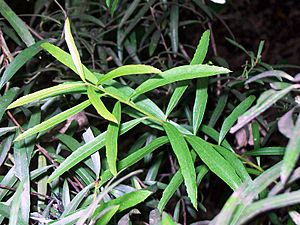Narrow leaved orangebark facts for kids
Quick facts for kids Narrow leaved orangebark |
|
|---|---|
 |
|
| Maytenus silvestris from Eastwood, Australia | |
| Scientific classification | |
| Genus: |
Maytenus
|
| Species: |
silvestris
|
Maytenus silvestris is a cool shrub or small tree found in parts of Australia. It grows from Picton, New South Wales in the south up to Gladstone, Queensland in the north. You might hear it called narrow leaved orangebark, orange bush, or orange bark. It often grows in dry rainforests or areas where eucalyptus forests meet rainforests.
How it Looks
Maytenus silvestris usually looks like a thick, dark green shrub. It is often about two metres tall. But sometimes, it can grow much taller, like a small tree. These trees can reach 10 to 15 metres high. Their trunks can be up to 25 centimetres thick.
The tree's trunk is often bent or not perfectly straight. Its outer bark is greyish-brown or grey. It feels quite smooth but has small spots called lenticels. These spots help the plant breathe. The inner bark can be green, brown, or reddish. When this reddish bark shows through, it gives the tree its common name, "Orange Bark."
The leaves are usually 10 to 80 millimetres long. They are narrow, like a spear tip (this shape is called lanceolate). Some leaves are wider, like an egg (this is called ovate). The edges of the leaves might be slightly curved. They can have small teeth or be completely smooth. The tip of the leaf might also be curved. The leaf base slowly gets thinner where it connects to the stem.
The leaf stalks are short, about 2 to 5 millimetres long. You can see the leaf veins on both sides of the leaf. There are usually 5 to 8 pairs of side veins. New shoots on the plant are soft and fuzzy.
Flowers and Fruit
Maytenus silvestris has pale green flowers. They grow in small clusters called racemes from where the leaves meet the stem (the leaf axils). The flowers can appear alone, or in groups of two or three.
This plant usually flowers from October to January. Sometimes, it flowers as late as Easter. The fruit is a round, orange capsule. It is small, about 3 to 7 millimetres wide.
When the fruit is ripe, it splits into two halves. Inside, you will find one to four shiny brown seeds. Each seed is covered in a bright orange, fleshy layer called an aril. The seeds are shaped like an egg and are about 4 to 5 millimetres long. The fruit usually ripens from February to May. If you plant the seeds, they usually sprout well within 42 days.

